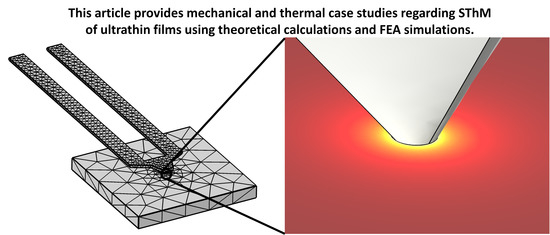Scanning Thermal Microscopy of Ultrathin Films: Numerical Studies Regarding Cantilever Displacement, Thermal Contact Areas, Heat Fluxes, and Heat Distribution
Abstract
1. Introduction
2. Materials and Methods
- Thermal probe: SThM probe Bruker VITA-DM-NANOTA-200 (Bruker Corporation, Billerica, MA, USA) [19,20]; The thermal probe is made from crystalline Si and can be heated repeatedly and reliably up to temperatures of 350 °C, according to manufacturer information. Consecutively, we use the term “probe” for the whole thermal probe (as it can be purchased), the term “cantilever” for the flexible mechanical part of the probe, and the term “tip” only for the sharp area on the front side of the probe, which is in direct contact with the surface of the samples.
- SEM investigation: Zeiss ULTRA 55 (Carl Zeiss AG, Oberkochen, Germany);
- Modeling process: SolidWorks 2020 (SW; Dassault Systemes Deutschland GmbH, Stuttgart, Germany);
- Simulations: COMSOL Multiphysics 5.5 (CM; Comsol Multiphysics GmbH, Göttingen, Germany), which is a versatile FEA tool to simulate, e.g., heat transfer or mechanical problems that can be described by mathematical equations.
3. Theoretical Background
3.1. Cantilever Displacement
3.2. Hertzian Surface Pressure
3.3. Heat Transfer
4. Results and Discussion
4.1. SEM Investigation of a Used SThM Tip
4.2. Cantilever Displacement and Von Mises Stress
- Total displacement: 0.114 µm at the center point of the tip and 0.119 µm at the free end of the cantilever;
- Maximum von Mises stress at the fixed end of the cantilever: 1.26 × 106 Nm−2.
4.3. Calculation of TCAs in Realistic SThM Investigations
4.4. Heat Spreading in SThM Measurements Regarding Ultrathin h-BN Film
- k: Ratio between in-plane and cross-plane thermal conductivity with [31]. In the parametric sweep studies in this section, k resembles the values 1, 2, 5, 10, 20, 50, and 100;
- temp: Temperature of the top surface of the SThM cantilever (boundary condition in Figure 4). In the parametric sweeps, temp takes on the values from 50 °C to 200 °C in steps of 25 °C. For reasons of better differentiation and easier comparison with practical measurements, temp is always specified in °C, whereas all other temperatures are specified in K.
- We assume an ideal thermal contact between tip and sample in Section 4.4 to Section 4.7. TIRs in practical SThM measurements are quite hard to estimate as they depend on numerous factors such as surface roughness, material combination, vertical steps, tip material and geometry, contaminations, tip force, and some more. Due to these numerous influences, TIR will also vary greatly during a single SThM measurement. In literature, values in the range of 10−8 Km2W−1 to 10−10 Km2W−1 for different probes, samples, and measurement scenarios can be found [35,36,37]. Indeed, we assume the TIR to vary in a broader range due to the great number of possible measurement scenarios. To realize a comparison between the simulations in Section 4.4 and Section 4.5, we assume an ideal thermal contact in said sections. The influence of a possible TIR is further studied in Section 4.8. It must also be stated that the present investigation in Section 4.4 focuses on ultrathin h-BN samples, which in fact are super flat as they are built of a stack of single h-BN layers. Roughnesses of high-quality h-BN are assumed to be less than 0.4 nm [38], which is significantly lower compared to a tip radius of 300 nm. As surface roughness has a great impact on TIR, values for h-BN samples should be lower compared to samples with higher roughnesses;
- We neglect a possible water meniscus around the tip. Other researchers also propose that a water meniscus can often be neglected in SThM measurements [22]. On one hand, a present water drop could cause heat conduction and may increase the amount of heat flux between tip and sample slightly. On the other hand, SThM measurements can also be performed under high vacuum conditions, where the appearance of a water meniscus can be excluded. We, therefore, focus on simulations without a possible water meniscus;
- In practical SThM measurements, the probe is scanning over the surface with a specific velocity. This is not presentable in simulations in the stationary regime, where a motionless probe is assumed. However, we justify such simulations in Section 4.6 through the investigation of the time until heat distribution is stationary;
- We also neglect radiation and convection as the influence on our simulated cases is neglectable. This is further discussed in Section 4.7.
4.5. Heat Spreading in SThM Measurements Regarding a Bulk Si Sample
4.6. Stationary Time of Heat Distribution
4.7. Influence of Convection and Radiation
4.8. Influence of the TIR at the TCA regarding the TAR and the NTEF
4.9. Mesh Verification
5. Conclusions
Author Contributions
Funding
Institutional Review Board Statement
Informed Consent Statement
Data Availability Statement
Acknowledgments
Conflicts of Interest
References
- Cahill, D.G.; Goodson, K.; Majumdar, A. Thermometry and Thermal Transport in Micro/Nanoscale Solid-State Devices and Structures. J. Heat Transf. 2002, 124, 223–241. [Google Scholar] [CrossRef]
- Cahill, D.G.; Ford, W.K.; Goodson, K.E.; Mahan, G.D.; Majumdar, A.; Maris, H.J.; Merlin, R.; Phillpot, S.R. Nanoscale thermal transport. J. Appl. Phys. 2003, 93, 793–818. [Google Scholar] [CrossRef]
- Choi, S.R.; Kim, D.; Choa, S.-H.; Lee, S.-H.; Kim, J.-K. Thermal Conductivity of AlN and SiC Thin Films. Int. J. Thermophys 2006, 27, 896–905. [Google Scholar] [CrossRef]
- Cahill, D.G.; Braun, P.V.; Chen, G.; Clarke, D.R.; Fan, S.; Goodson, K.E.; Keblinski, P.; King, W.P.; Mahan, G.D.; Majumdar, A.; et al. Nanoscale thermal transport. II. 2003–2012. Appl. Phys. Rev. 2014, 1, 11305. [Google Scholar] [CrossRef]
- Price, D.M.; Reading, M.; Hammiche, A.; Pollock, H.M. Micro-thermal analysis: Scanning thermal microscopy and localised thermal analysis. Int. J. Pharm. 1999, 192, 85–96. [Google Scholar] [CrossRef]
- Ruiz, F.; Sun, W.D.; Pollak, F.H.; Venkatraman, C. Determination of the thermal conductivity of diamond-like nanocomposite films using a scanning thermal microscope. Appl. Phys. Lett. 1998, 73, 1802–1804. [Google Scholar] [CrossRef]
- Sadeghi, M.M.; Park, S.; Huang, Y.; Akinwande, D.; Yao, Z.; Murthy, J.; Shi, L. Quantitative scanning thermal microscopy of graphene devices on flexible polyimide substrates. J. Appl. Phys. 2016, 119, 235101. [Google Scholar] [CrossRef]
- Martinek, J.; Klapetek, P.; Campbell, A.C. Methods for topography artifacts compensation in scanning thermal microscopy. Ultramicroscopy 2015, 155, 55–61. [Google Scholar] [CrossRef]
- Shi, L.; Plyasunov, S.; Bachtold, A.; McEuen, P.L.; Majumdar, A. Scanning thermal microscopy of carbon nanotubes using batch-fabricated probes. Appl. Phys. Lett. 2000, 77, 4295–4297. [Google Scholar] [CrossRef]
- Hammiche, A.; Pollock, H.M.; Song, M.; Hourston, D.J. Sub-surface imaging by scanning thermal microscopy. Meas. Sci. Technol. 1996, 7, 142–150. [Google Scholar] [CrossRef]
- Majumdar, A. SCANNING THERMAL MICROSCOPY. Annu. Rev. Mater. Sci. 1999, 29, 505–585. [Google Scholar] [CrossRef]
- Metzke, C.; Frammelsberger, W.; Weber, J.; Kühnel, F.; Zhu, K.; Lanza, M.; Benstetter, A.G. On the Limits of Scanning Thermal Microscopy of Ultrathin Films. Materials 2020, 13, 518. [Google Scholar] [CrossRef] [PubMed]
- Leitgeb, V.; Fladischer, K.; Mitterhuber, L.; Defregger, S. Quantitative SThM Characterization for Heat Dissipation Through Thin Layers. In Proceedings of the 2019 25th International Workshop on Thermal Investigations of ICs and Systems (THERMINIC), Lecco, Italy, 25–27 September 2019; pp. 1–4, ISBN 978-1-7281-2078-2. [Google Scholar]
- Fladischer, K.; Leitgeb, V.; Mitterhuber, L.; Maier, G.A.; Keckes, J.; Sagmeister, M.; Carniello, S.; Defregger, S. Combined thermo-physical investigations of thin layers with Time Domain Thermoreflectance and Scanning Thermal Microscopy on the example of 500 nm thin, CVD grown tungsten. Thermochim. Acta 2019, 681, 178373. [Google Scholar] [CrossRef]
- Chen, W.; Feng, Y.; Qiu, L.; Zhang, X. Scanning thermal microscopy method for thermal conductivity measurement of a single SiO2 nanoparticle. Int. J. Heat Mass Transf. 2020, 154, 119750. [Google Scholar] [CrossRef]
- Park, J.; Koo, S.; Kim, K. Measurement of thermal boundary resistance in ∼10 nm contact using UHV-SThM. IJNT 2019, 16, 263. [Google Scholar] [CrossRef]
- Chirtoc, M.; Bodzenta, J.; Kaźmierczak-Bałata, A. Calibration of conductance channels and heat flux sharing in scanning thermal microscopy combining resistive thermal probes and pyroelectric sensors. Int. J. Heat Mass Transf. 2020, 156, 119860. [Google Scholar] [CrossRef]
- Nguyen, T.P.; Thiery, L.; Euphrasie, S.; Lemaire, E.; Khan, S.; Briand, D.; Aigouy, L.; Gomes, S.; Vairac, P. Calibration Tools for Scanning Thermal Microscopy Probes Used in Temperature Measurement Mode. J. Heat Transf. 2019, 141. [Google Scholar] [CrossRef]
- Bruker. VITA—NanoTA. Available online: https://www.brukerafmprobes.com/c-206-vita-nanota.aspx (accessed on 9 December 2020).
- Bruker. VITA-DM-NANO-TA-200. Available online: https://www.brukerafmprobes.com/p-3701-vita-dm-nanota-200.aspx (accessed on 9 December 2020).
- Born, A. Nanotechnologische Anwendungen der Rasterkapazitätsmikroskopie und Verwandter Rastersondenmethoden. Ph.D. Thesis, Universität Hamburg, Hamburg, Germany, 2000. [Google Scholar]
- Zhang, Y.; Zhu, W.; Hui, F.; Lanza, M.; Borca-Tasciuc, T.; Muñoz Rojo, M. A Review on Principles and Applications of Scanning Thermal Microscopy (SThM). Adv. Funct. Mater. 2019, 107, 1900892. [Google Scholar] [CrossRef]
- Hering, E.; Modler, K.-H. (Eds.) Grundwissen des Ingenieurs; 14.,aktualisierte Aufl; Fachbuchverl. Leipzig im Carl-Hanser-Verl: München, Germany, 2007; ISBN 978-3-446-22814-6. [Google Scholar]
- Popov, V.L. Rigorose Behandlung des Kontaktproblems–Hertzscher Kontakt. Kontaktmechanik und Reibung; Springer: Berlin/Heidelberg, Germany, 2009; pp. 57–72. ISBN 978-3-540-88836-9. [Google Scholar]
- Nitsche, K.; Marek, R. Praxis der Wärmeübertragung. Grundlagen, Anwendungen, Übungsaufgaben; mit 48 Tabellen, 50 vollständig durchgerechneten Beispielen sowie 93 Übungsaufgaben mit Lösungen; Fachbuchverl. Leipzig im Carl Hanser Verl.: München, Germany, 2007; ISBN 9783446409996. [Google Scholar]
- Korth Kristalle GmbH. Silizium (Si). Available online: https://www.korth.de/index.php/material-detailansicht/items/32.html (accessed on 9 December 2020).
- Frühauf, J. Shape and Functional Elements of the Bulk Silicon Microtechnique. A Manual of Wet-Etched Silicon Structures; Springer: Berlin/Heidelberg, Germany, 2005; ISBN 978-3-540-26876-5. [Google Scholar]
- Falin, A.; Cai, Q.; Santos, E.J.G.; Scullion, D.; Qian, D.; Zhang, R.; Yang, Z.; Huang, S.; Watanabe, K.; Taniguchi, T.; et al. Mechanical properties of atomically thin boron nitride and the role of interlayer interactions. Nat. Commun. 2017, 8, 15815. [Google Scholar] [CrossRef]
- Boldrin, L.; Scarpa, F.; Chowdhury, R.; Adhikari, S. Effective mechanical properties of hexagonal boron nitride nanosheets. Nanotechnology 2011, 22, 505702. [Google Scholar] [CrossRef]
- Frammelsberger, W.; Benstetter, G.; Kiely, J.; Stamp, R. C-AFM-based thickness determination of thin and ultra-thin SiO 2 films by use of different conductive-coated probe tips. Appl. Surf. Sci. 2007, 253, 3615–3626. [Google Scholar] [CrossRef]
- Jiang, L.; Shi, Y.; Hui, F.; Tang, K.; Wu, Q.; Pan, C.; Jing, X.; Uppal, H.; Palumbo, F.; Lu, G.; et al. Dielectric Breakdown in Chemical Vapor Deposited Hexagonal Boron Nitride. ACS Appl. Mater. Interfaces 2017, 9, 39758–39770. [Google Scholar] [CrossRef]
- Villaroman, D.; Wang, X.; Dai, W.; Gan, L.; Wu, R.; Luo, Z.; Huang, B. Interfacial thermal resistance across graphene/Al2O3 and graphene/metal interfaces and post-annealing effects. Carbon 2017, 123, 18–25. [Google Scholar] [CrossRef]
- Hong, Y.; Zhang, J.; Zeng, X.C. Thermal contact resistance across a linear heterojunction within a hybrid graphene/hexagonal boron nitride sheet. Phys. Chem. Chem. Phys. 2016, 18, 24164–24170. [Google Scholar] [CrossRef]
- Zhang, J.; Wang, Y.; Wang, X. Rough contact is not always bad for interfacial energy coupling. Nanoscale 2013, 5, 11598–11603. [Google Scholar] [CrossRef] [PubMed]
- Timofeeva, M.; Bolshakov, A.; Tovee, P.D.; Zeze, D.A.; Dubrovskii, V.G.; Kolosov, O.V. Nanoscale Resolution Scanning Thermal Microscopy with Thermally Conductive Nanowire Probes. arXiv 2013, arXiv:1309.2010. Available online: http://arxiv.org/pdf/1309.2010v1 (accessed on 9 December 2020).
- Kim, K.; Jeong, W.; Lee, W.; Sadat, S.; Thompson, D.; Meyhofer, E.; Reddy, P. Quantification of thermal and contact resistances of scanning thermal probes. Appl. Phys. Lett. 2014, 105, 203107. [Google Scholar] [CrossRef]
- Timofeeva, M.; Bolshakov, A.; Tovee, P.D.; Zeze, D.A.; Dubrovskii, V.G.; Kolosov, O.V. Scanning thermal microscopy with heat conductive nanowire probes. Ultramicroscopy 2016, 162, 42–51. [Google Scholar] [CrossRef] [PubMed]
- Song, Y.; Mandelli, D.; Hod, O.; Urbakh, M.; Ma, M.; Zheng, Q. Robust microscale superlubricity in graphite/hexagonal boron nitride layered heterojunctions. Nat. Mater. 2018, 17, 894–899. [Google Scholar] [CrossRef]
- Hwang, G.; Chung, J.; Kwon, O. Enabling low-noise null-point scanning thermal microscopy by the optimization of scanning thermal microscope probe through a rigorous theory of quantitative measurement. Rev. Sci. Instrum. 2014, 85, 114901. [Google Scholar] [CrossRef] [PubMed]
- Assy, A.; Gomès, S. Heat transfer at nanoscale contacts investigated with scanning thermal microscopy. Appl. Phys. Lett. 2015, 107, 43105. [Google Scholar] [CrossRef]
- Ravindra, N.M.; Sopori, B.; Gokce, O.H.; Cheng, S.X.; Shenoy, A.; Jin, L.; Abedrabbo, S.; Chen, W.; Zhang, Y. Emissivity Measurements and Modeling of Silicon-Related Materials: An Overview. Int. J. Thermophys 2001, 22, 1593–1611. [Google Scholar] [CrossRef]
- Cerbe, G.; Hoffmann, H.-J. Einführung in die Wärmelehre. Von der Thermodynamik zur technischen Anwendung; mit 30 Tafeln, 111 Beispielen, 119 Aufgaben und 161 Kontrollfragen; 9., verb. Aufl; Hanser: München, Germany, 1990; ISBN 9783446159525. [Google Scholar]
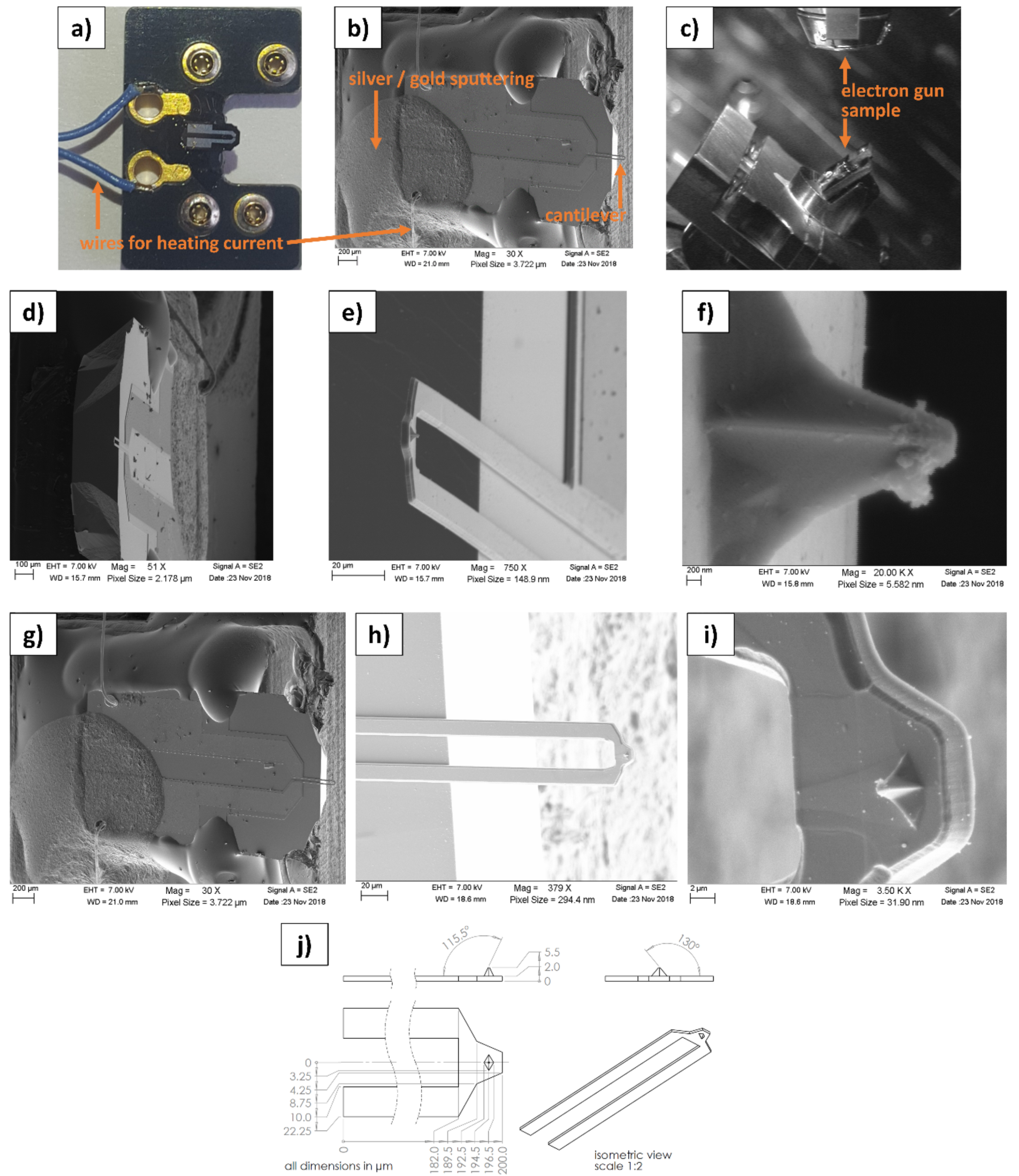

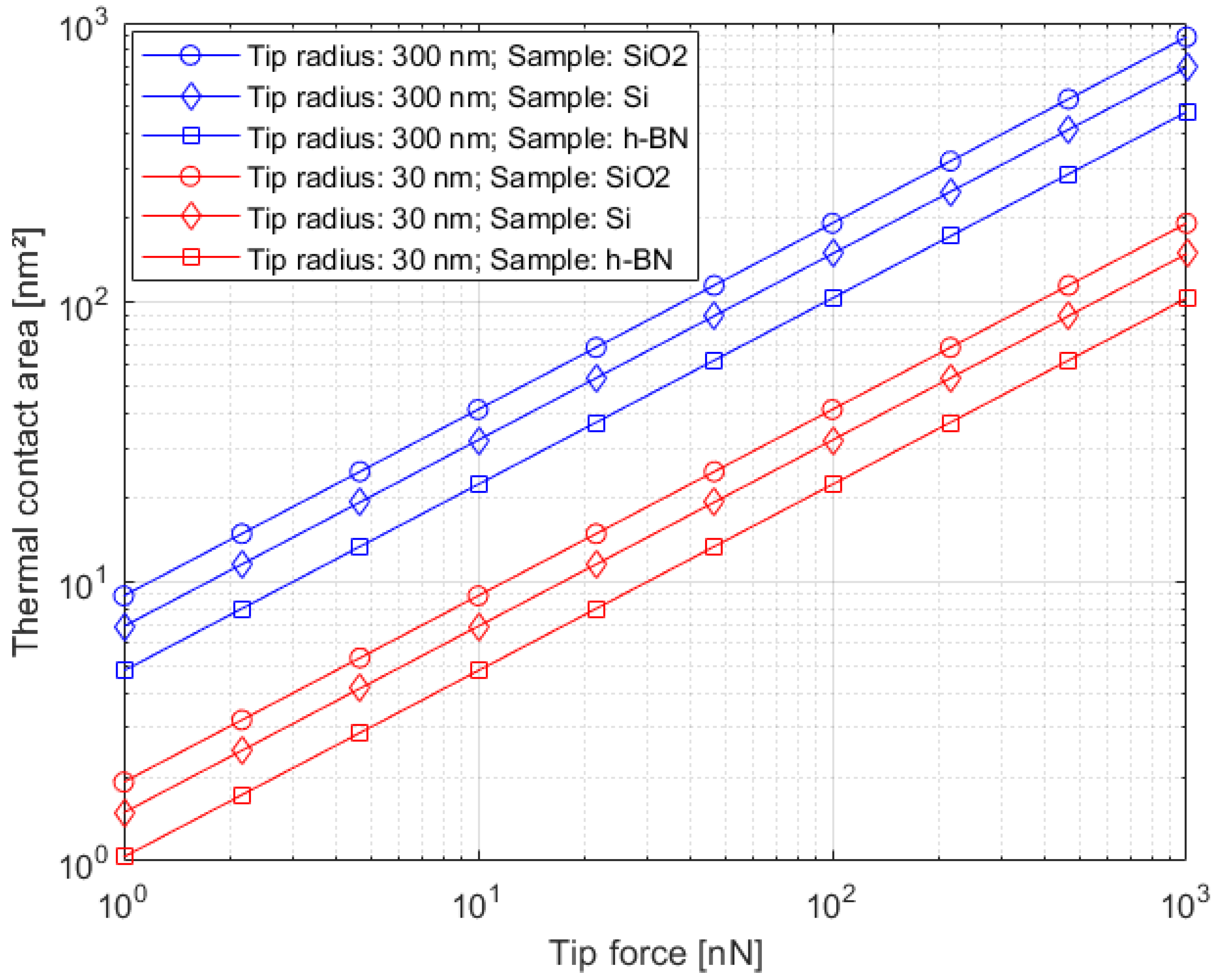



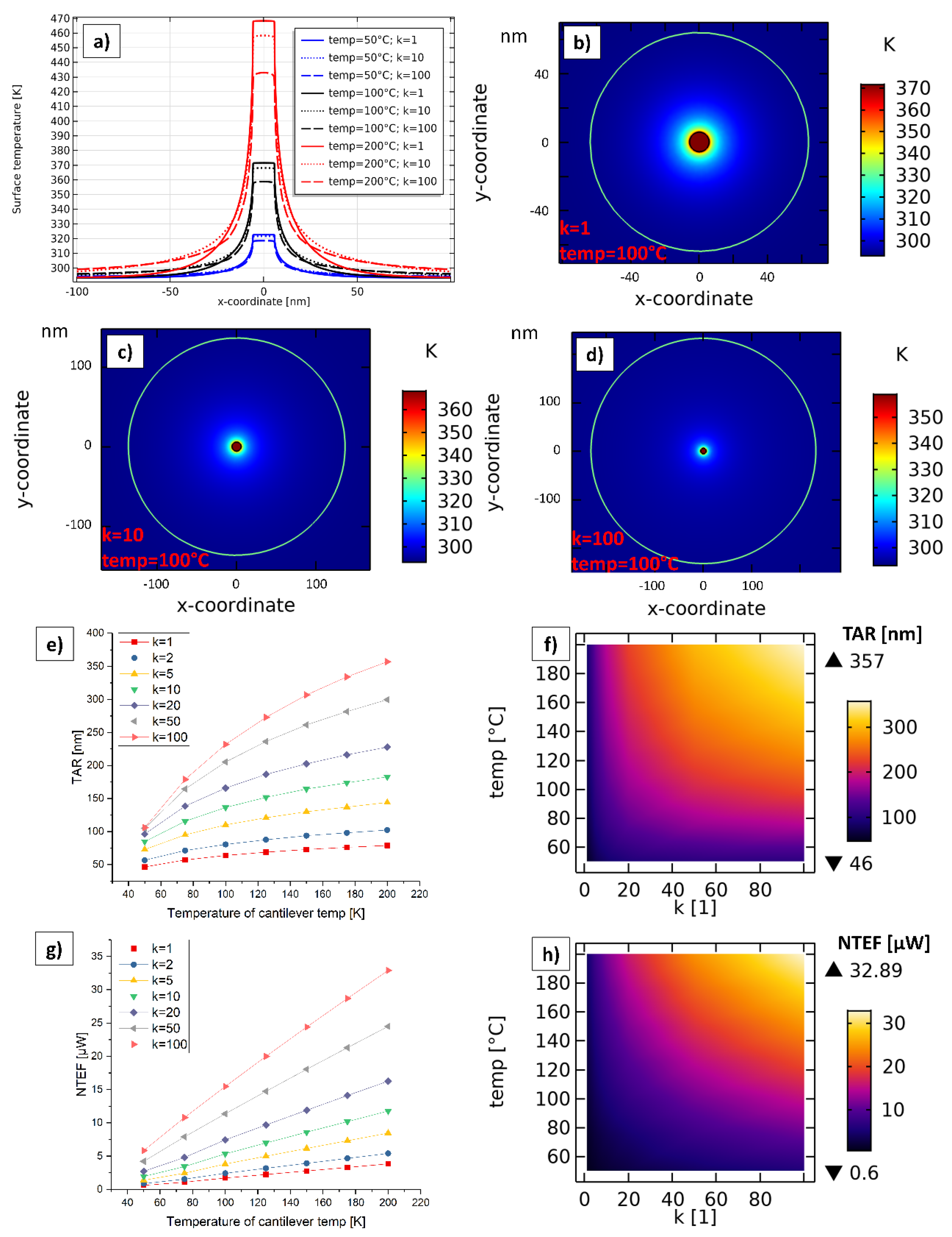
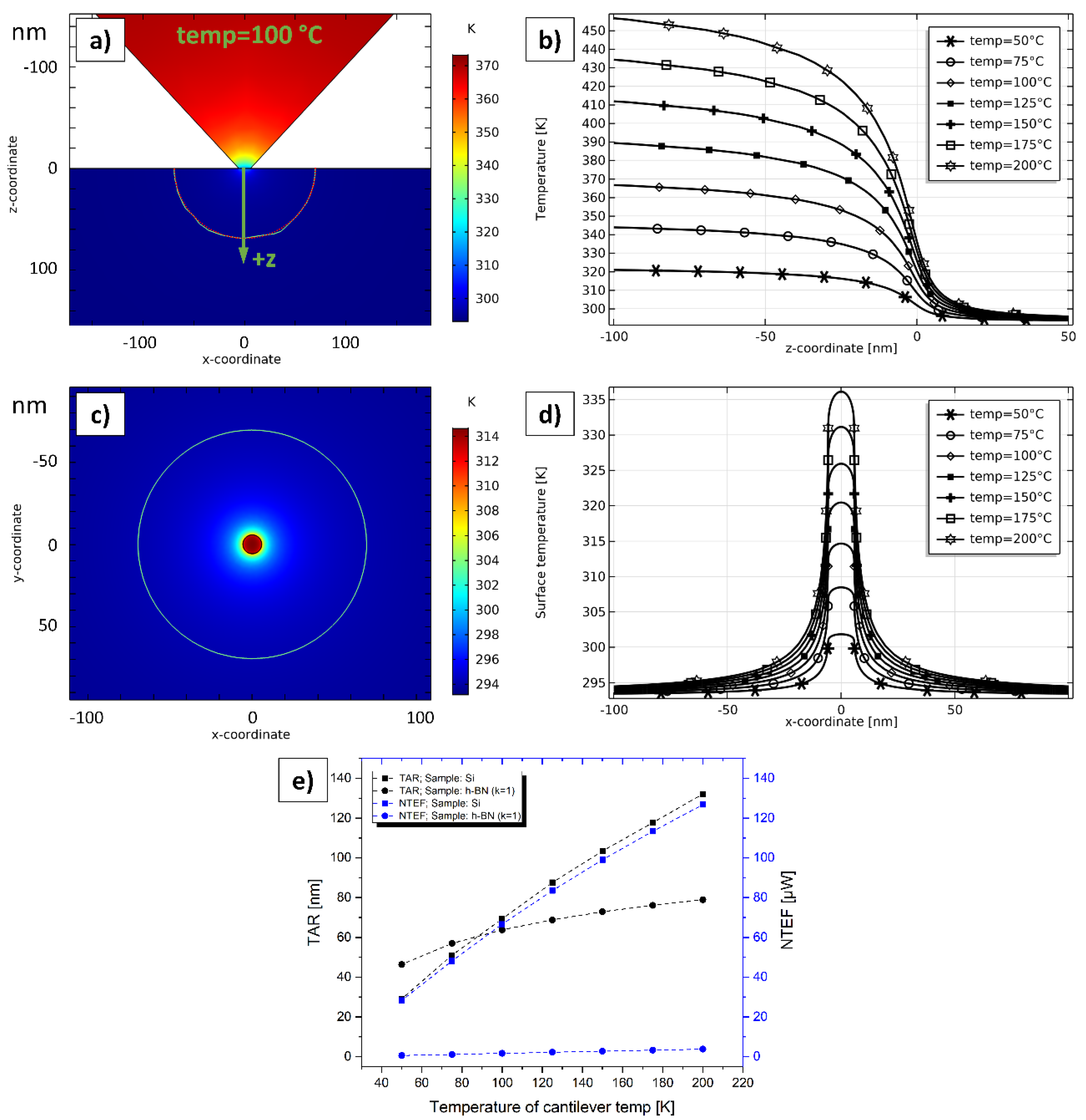
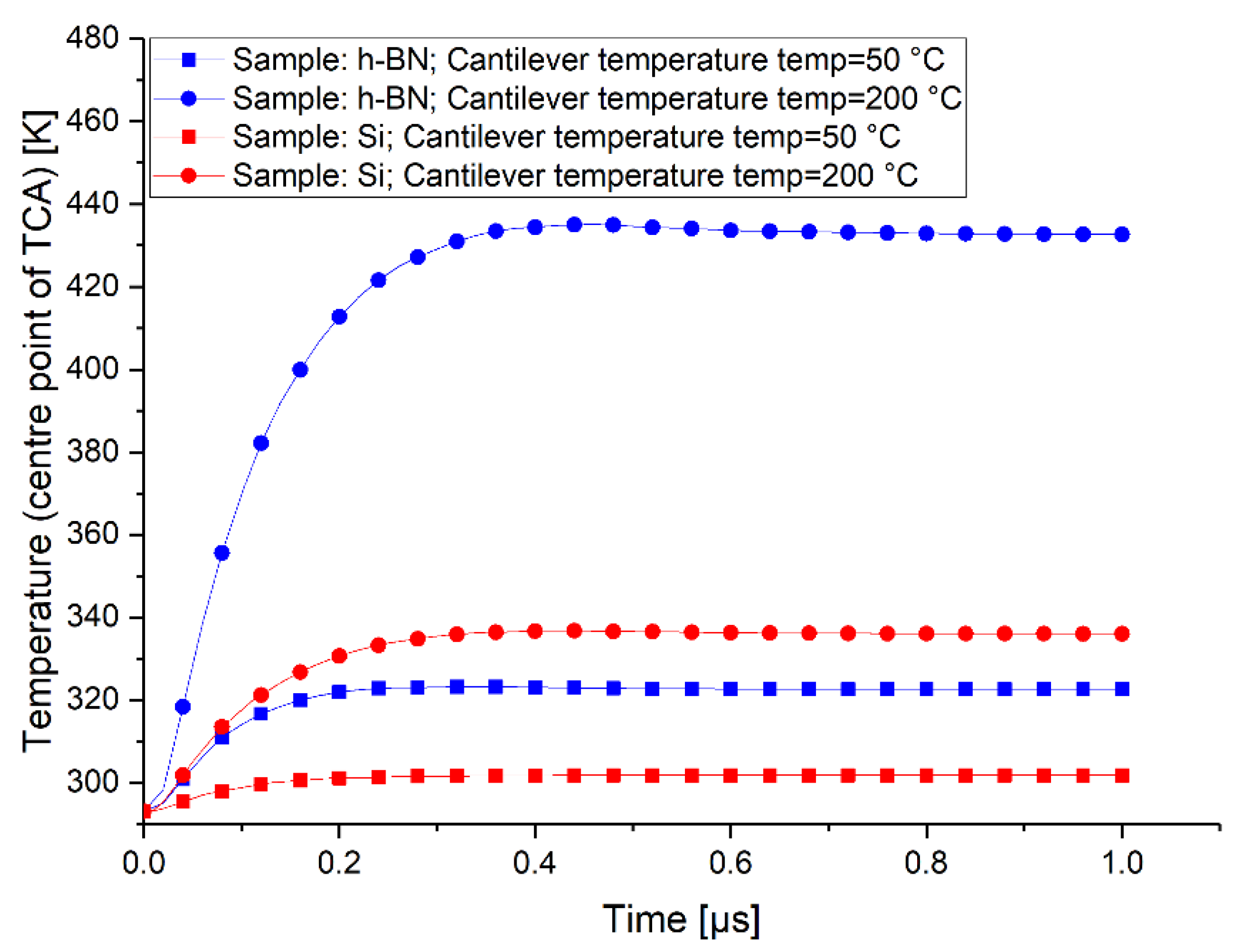


| Material | Si | SiO2 | h-BN |
|---|---|---|---|
| Young’s modulus (GPa) | 131 [26] | 70 | 850 [28] |
| Poisson’s ratio (–) | 0.221 [26] | 0.157 | 0.2 [29] |
Publisher’s Note: MDPI stays neutral with regard to jurisdictional claims in published maps and institutional affiliations. |
© 2021 by the authors. Licensee MDPI, Basel, Switzerland. This article is an open access article distributed under the terms and conditions of the Creative Commons Attribution (CC BY) license (http://creativecommons.org/licenses/by/4.0/).
Share and Cite
Metzke, C.; Kühnel, F.; Weber, J.; Benstetter, G. Scanning Thermal Microscopy of Ultrathin Films: Numerical Studies Regarding Cantilever Displacement, Thermal Contact Areas, Heat Fluxes, and Heat Distribution. Nanomaterials 2021, 11, 491. https://doi.org/10.3390/nano11020491
Metzke C, Kühnel F, Weber J, Benstetter G. Scanning Thermal Microscopy of Ultrathin Films: Numerical Studies Regarding Cantilever Displacement, Thermal Contact Areas, Heat Fluxes, and Heat Distribution. Nanomaterials. 2021; 11(2):491. https://doi.org/10.3390/nano11020491
Chicago/Turabian StyleMetzke, Christoph, Fabian Kühnel, Jonas Weber, and Günther Benstetter. 2021. "Scanning Thermal Microscopy of Ultrathin Films: Numerical Studies Regarding Cantilever Displacement, Thermal Contact Areas, Heat Fluxes, and Heat Distribution" Nanomaterials 11, no. 2: 491. https://doi.org/10.3390/nano11020491
APA StyleMetzke, C., Kühnel, F., Weber, J., & Benstetter, G. (2021). Scanning Thermal Microscopy of Ultrathin Films: Numerical Studies Regarding Cantilever Displacement, Thermal Contact Areas, Heat Fluxes, and Heat Distribution. Nanomaterials, 11(2), 491. https://doi.org/10.3390/nano11020491





